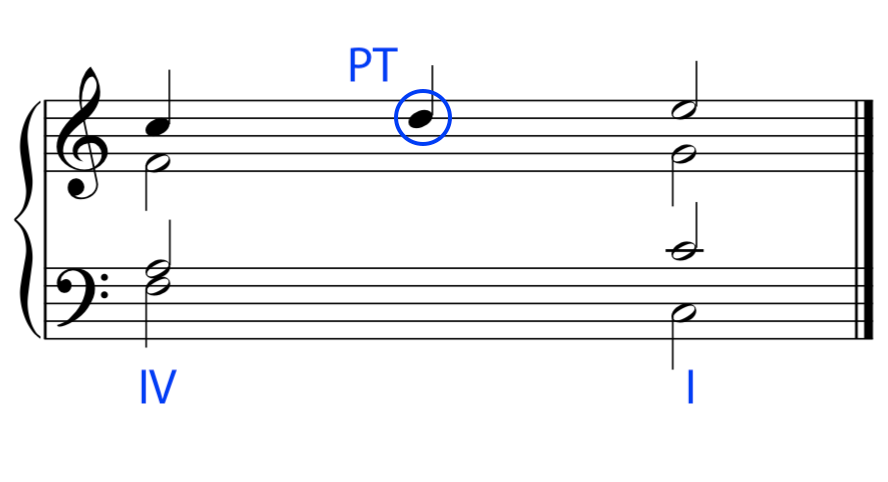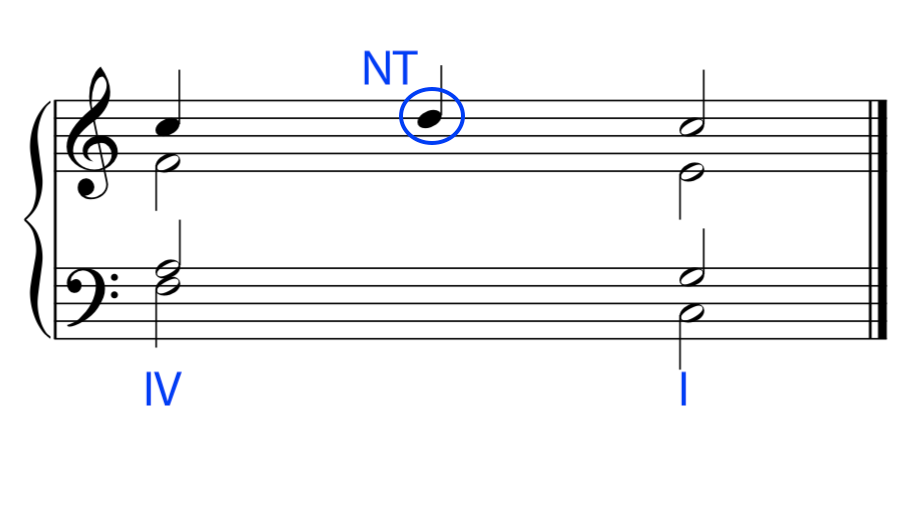<< Hide Menu
6.1 Embellishing Tones: Identifying Passing Tones and Neighbor Tones
7 min read•june 18, 2024
Sumi Vora
Sumi Vora
If music was just chord progressions and there was no melody, the music would be pretty boring and repetitive. In order to add expression and make the individual lines of music more complex, composers often add additional notes, ornaments, or figures added to a melody to enhance its expression and interest. These embellishments are used to add complexity and interest to a melody. They can also be used to add a sense of ornamentation or decoration to a melody. Embellishments can be diatonic or chromatic, meaning they come from within the key or scale being used, or they can come from outside of it. We often call these notes non-chord tones, meaning that they are notes played that don’t belong to any of the harmonies in the music.
Passing Tones
A passing tone in music is a non-chord tone that is played or sung briefly as a transition between two chord tones in a melody or harmony. It is typically used to create a sense of movement or tension and release in a piece of music. They are used to connect or "pass" between the strong and stable tones of a chord, adding a sense of motion and flow to the music. If there are skips or leaps between successive chords in a harmonic progression, adding a passing tone or multiple passing tones can also help to improve voice leading and ensure that voices are mostly moving in a stepwise manner.
Let’s consider an example, where we move from a I chord to a iii chord in a melody. In the bass line, we will have a tonic followed by a mediant. In between the tonic and mediant, we might add a supertonic passing tone so that the bass line moves stepwise from the tonic to the supertonic to the mediant. For example, if we are in Ab Major, we might have an Ab-Bb-C melody in the bass line.
Most of the time, though, we add melodic embellishments and non-chord tones to the upper voices – specifically the soprano line. This is because when you are playing music, your ears usually interpret the higher notes as the “melody line,” and the lower notes as the harmonic accompaniment. So, when adding passing tones, focus on incorporating them into the soprano line.
It is okay to add multiple passing tones between two voices. For example, if the soprano voice must leap from a C to an F, you can add a D and an E between the two chord tones. Be careful to make sure that you are counting correctly when you do this! For example, if the harmonic rhythm is in half notes, it would be wrong to add three quarter notes in passing tones in the soprano line. Instead, you may consider having the chord tone be a quarter note, and the two passing tones following it to be eighth notes. Unless you are writing a suspension, which we will cover in later units, it should always be the case that the chord tone falls on the “harmonic beat,” so to speak.
Usually, passing tones, as well as almost all other embellishments, should be written on the weaker beats. However, we can classify passing tones as accented or unaccented. An unaccented passing tone is written on a weaker beat in comparison to the chord tones surrounding it. An accented passing tone is written on a stronger beat than the chord tones surrounding it. As you can see, writing an accented passing tone requires disrupting the harmonic rhythm of the piece, which can be done in order to create tension and rhythmic interest, but was usually done sparingly by composers in the Common Practice Era.
Next, let’s look at an example of passing tones:

Image via https://kaitlinbove.com/nonharmonic-tones
Passing tones can also be chromatic, meaning that they don’t fall within the diatonic scale of the key that the piece of music is written in. This often happens when voices are moving stepwise, but the composer still wants to add a passing tone in order to create melodic interest. For example, if a voice is moving from C to D, the composer might add a chromatic passing tone such that the voice goes from C to C# to D. If the composer is connecting a skip or a leap, they might also use part of the chromatic scale in order to add passing tones between the two chord tones. For example, when leaping down from an A to an F, they might add the passing tones G#-G-F# in order to create the chromatic melodic line A-G#-G-F#-F. Chopin’s Waltz Op 69 No 2 gives a good example of these types of chromatic passing tones.
Neighbor Tones
A neighbor tone in music is a non-chord tone that is played or sung immediately before or after a chord tone within a melody or harmony. Neighbor tones are used when a chord tone is sustained from one chord to another, meaning that the note in the voice stays the same for both chords. In this case, adding a neighbor tone means adding a note above or below the sustained note. For example, if there is a C in the soprano voice that is sustained for two chords, you can step down such that you have a C-B-C melody in the soprano voice.
A neighbor tone is similar to a passing tone in that it is used to create a sense of movement or tension and release in a piece of music, but it typically stays within a smaller range and returns to the same chord tone it started from. Neighbor tones are often used to create a sense of ornamentation or decoration in a melody and can be used to create a sense of anticipation or delay in the resolution of a chord. There are two types of neighbor tones: upper neighbor and lower neighbor. An upper neighbor tone occurs when a note is approached by a note of a higher pitch and then returns to the original note. A lower neighbor tone is when a note is approached by a note of a lower pitch and then returns to the original note.
Here is an example of a neighbor tone:

Image via https://kaitlinbove.com/nonharmonic-tones
Just like passing tones, neighbor tones can either be diatonic (meaning that the neighbor tone is within the diatonic scale of the key that the piece is written in) or they can be chromatic (meaning that the neighbor tone is outside of the diatonic scale that the piece is written in). Either way, in order to be classified as a neighbor tone, the voice must move stepwise. In a C-E-C melody, the E would not be considered an upper neighbor tone. (It is actually an escape tone, which we will learn about in section 6.3).
More on Non Chord Tones
There are two important pieces of vocabulary that you should become familiar with when it comes to writing non chord tones: the preparation and the resolution.
The preparation is the chord tone that comes right before a melodic embellishment or series of non chord tones. Let’s look at the example of chromatic passing tones that we discussed earlier. If we have A and F as our chord tones, and the chromatic scale G#-G-F# as our passing tones, then the A will be considered the preparation for the melodic embellishment. Similarly, the F would be considered the resolution to the melodic embellishment – it is the note that “resolves” us back to the harmonic progression.
These terms are important because both passing and neighbor tones are usually considered dissonant, regardless of whether they are diatonic or chromatic non-chord tones. For example, if we consider a passing tone between C and E in two successive tonic chords, adding a diatonic D on top of the tonic harmony will introduce a dissonant interval in the progression, which creates tension. Therefore, it is important to “resolve” the non-chord tones with a consonant chord tone.
Another important type of non chord tone is an ornament. Ornamentation in music refers to the addition of decorations to a melody or harmony. These embellishments can include techniques such as grace notes, trills, mordents, and turns, as well as other ornamental figures such as vibrato, slides, and slides. Ornamentation is used to add complexity and interest to a melody, and can also be used to add a sense of expression or emphasis to a particular note or phrase.
In some types of music, ornamentations can be improvised. If you play classical music, you might notice that there is some freedom in interpreting how, when, and whether ornamentations are played, especially in later music. For example, pedaling and vibrato aren't always written explicitly. However, in the common practice era, ornamentations were generally written directly into the score.
One type of ornament that will likely show up on the AP Music Theory exam is a trill. A trill in music is a type of ornamentation that involves the rapid alternation between two notes, typically a main note and the note immediately above or below it. The main note is usually a diatonic or chord tone, while the alternating note might be a diatonic note or a chromatic one. Trills are often indicated in sheet music with a "tr" or "trill" symbol, and they can be played or sung at different speeds, depending on the desired effect. Trills are often used to add a sense of virtuosity, excitement, or drama to a melody.
Here is an example of a trill written into a score:

Image via Wikimedia Commons
And, if you would like to listen to what a trill sounds like, a good piece is Mendelssohn’s Venetian Boat Song.

© 2025 Fiveable Inc. All rights reserved.